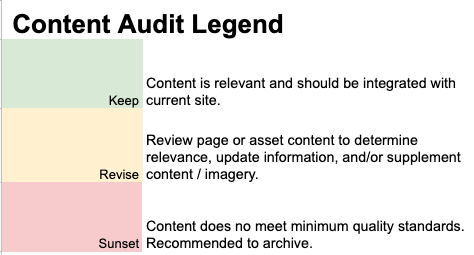With the massive amount of digital content that’s put in front of our eyes, it’s more important than ever for brands to fine-tune their practices to better manage, organize, and secure their content in an effort to stand out from the crowd.
If you’ve embarked on a content strategy for your ecommerce site, then you know it’s comprised of several pieces. Content governance is one critical piece of that strategy that is too often overlooked.
But what exactly is content governance, and why should you care? Simply put, content governance is a set of guidelines and processes that determine and dictate what, how, when, and why content is created, published, managed, and eventually deprecated. Internally, a well-executed content governance strategy can help make managing your site easier overall. Externally, it can lead to the generation of better targeted, focused content for your audience(s).
If your governance process isn’t where it should be — or is non-existent — here are some things to consider as you map a course forward.
WHY GOVERNANCE DOESN’T GET MORE ATTENTION
Content is a general term that encompasses a host of different things, which makes strategy inherently difficult. For your brand, content definitions likely differ across departments or divisions. That’s precisely why teams need to be aligned in order to execute an effective content strategy. This is where governance comes in.
While we often focus on the tangible aspects of content — such as substance and structure — governance shifts that focus to the people involved in the content workflow. Think of content management as the creation and distribution, and think of governance as the relationship management of every person and system touching that content.
Many organizations make the mistake of devoting nothing more than a CMS to content initiatives. Although a CMS is a key component of managing and disseminating content, it is not sufficient for establishing governance. After all, a CMS is only as good as the information that’s put into it.
So, how can you account for governance in your overall content strategy? Ideally, by creating an end-to-end process for the creation, delivery, and governance of content that is both useful, usable, and effective enough that it isn’t getting lost in a sea of digital information.
HERE ARE THE KEY COMPONENTS OF DEVELOPING A GOVERNANCE STRATEGY:
REVIEW YOUR CURRENT CONTENT STRATEGY
Refine where necessary to ensure governance can be effectively implemented into your overall process. The goal of any governance strategy should be to first gain a clear understanding of existing content, and determine how all teams touching it can work together to create consensus for the development and publication or dissemination of subsequent content. Implementing tools and activities including regular content inventories and content audits will help you better assess the current condition of your content.

Sample legend for content audit criteria.
DEFINE CONTENT OWNERSHIP AND ROLES
This will provide the framework for practical operation and directional support of your larger strategy. While this may seem tedious — particularly where resources are stretched thin — it is absolutely crucial. You must define ownership and roles before you can develop an effective workflow. Just as with roles dedicated to the technical aspects of your business, having clearly defined content roles will help avoid processes stalling. Determining who needs to be involved in the final approval is one of the most important designations. Aside from team members, make sure to account for any executive, regulatory, legal, or stakeholder approval necessary, as this is a common area where bottlenecks occur.
OUTLINE AND DOCUMENT WORKFLOWS/PROCESSES
Having common processes sets expectations that everyone understands. This means documenting how planning, production, and publishing of content will be handled, as well as who will have the final approval for each of these steps. If content initiation, ideation, measurement, and evaluation are currently ad hoc, you’ll reap significant benefit from formalizing a workflow. Once you have that workflow in place, it will be easier to document the processes and outline where specific roles fit in.
It’s helpful to visually document detailed workflows related to specific content types, taking into account existing resources, and identifying potential bottlenecks to successful content development.

Sample content creation workflow (abbreviated).
DEVELOP AND DOCUMENT GUIDELINES
Guidelines and templates for creating and disseminating content such as company briefs, press releases, blog posts, and social media content are imperative. This is supported by tools including an editorial style guide and editorial calendar. A style guide ensures consistency in elements including voice, tone, brand messaging, fonts, and color schemes across content types. And an editorial calendar can help with the methodical, intentional, and timely planning of content, while also outlining deadlines to keep things on track.

Sample editorial calendar.
OFFER TRAINING AND ENCOURAGE BUY-IN FROM ALL INVOLVED
As stated above, content governance is about the people involved. Once you’ve defined roles and developed guidelines and workflows, you’ll have to get buy-in across every department in order to see a meaningful impact and maintain momentum. Every person must know their part and be held accountable to execute it and evolve it as necessary. Conducting workflow trainings or regular process review meetings are great ways to keep your content governance strategy top of mind and reinforce its importance.
Based on your new framework, you’ll need to determine who needs to be trained on what, and how often. You can appoint subject matter experts to own some of these tasks, and to ensure that each person is up to speed on the latest and greatest changes impacting his or her role. You should also conduct monthly or quarterly editorial meetings. Including everyone involved in the ideation, creation and publishing of content will help foster buy-in by reinforcing the importance of content governance to your business.
THE TAKEAWAY
Properly executed, content governance enables you to proactively plan, manage and measure content, as well as the employees involved with creating and overseeing it. It is based around sound policies, procedures, regulations and standards. Defining and executing these things must be a top priority if you want to elevate your ecommerce brand above the competition.





